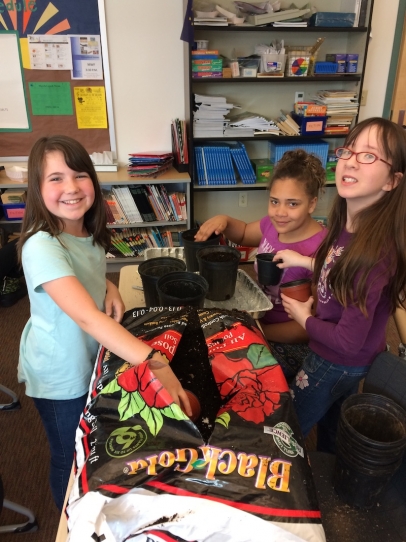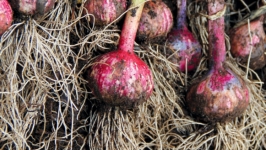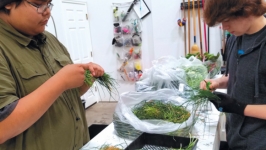Hands on in Haines
It was an unusually clear fall day in Haines, and my 4th grade students were eagerly digging up carrots and harvesting the chard and kale they had planted in the spring. Many of the onions and potatoes they grew were donated to the cafeteria at the Haines Borough School District. Other veggies were taken back to the classroom where the students used the new fraction skills I had been teaching them to triple zucchini muffin recipes. They also learned how to blend kale smoothies. It was wonderful to see students who had previously voiced their distaste for kale slurp down the delicious, dark-green beverage.
As a 4th grade teacher, this is one of my favorite times of the year. Students get rewarded for all their hard work in the garden. It all begins in spring when grades K-6th start seeds on their classroom window sills under grow lights. When May comes around, they proudly carry their seedlings out to their designated garden plot and carefully transplant kale, chard, cabbage, and other vegetables (and a few flowers) into the raised beds. They transfer tomato and pepper plants into larger pots in the hoop house.
Throughout the summer the students are invited to come to the garden for a weekly Youth Garden Club. They water and care for their plots, but they also do other fun projects like collecting insects for closer observation, turning the compost, and of course … harvesting veggies! My hope is that the positive experiences students associate with growing and caring for a garden will stick with them into their adult lives so they may always enjoy growing their own food.
The Starvin’ Marvin Garden is a project in collaboration between the Takshanuk Watershed Council (TWC) and the Haines Borough School District (HBSD). The garden was created in 2009 to meet the educational need to teach the youth of Haines about growing and harvesting their own vegetables. Food security is important in Haines because the vast majority of food that is not harvested locally is brought in by barge. It is often heavily packaged, which increases its cost and creates more waste. The amount of time it takes to bring food here also has an impact on its nutritional value once it arrives. By creating a school garden, TWC and HBSD were able to begin to address these problems in our community.
Technically, “Starvin’ Marvin” refers to the compost that is made up of school cafeteria food scraps, shredded office paper, and sawdust from the school’s woodshop. 6th grade students work with the education coordinator at TWC to collect food scraps from the cafeteria and wheelbarrow them out to the compost pile[a]. They collect and compost over 3,000 pounds of school lunch waste annually. The compost is then used in Marvin’s raised garden beds and hoop house.








